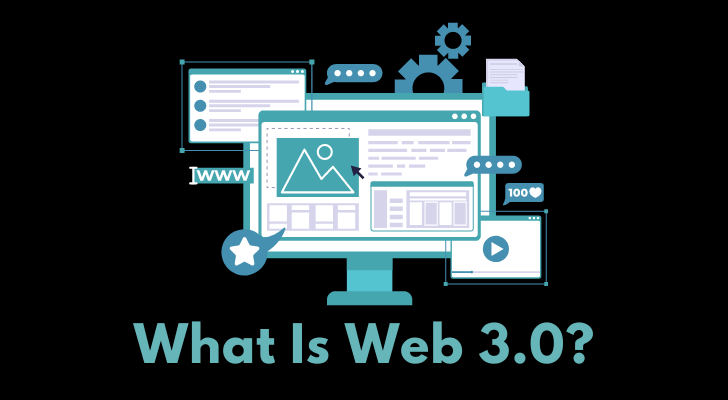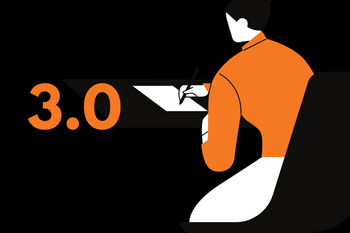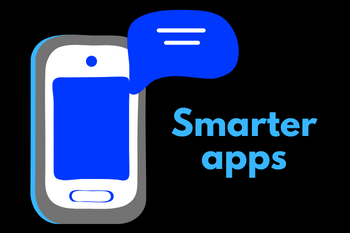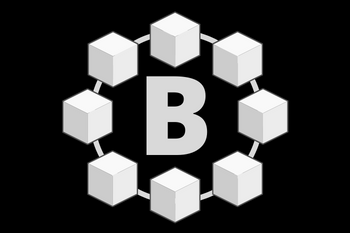The internet has come a long way since its inception in the early 1990s. We’ve gone from rudimentary HTML pages to dynamic, interactive websites powered by sophisticated backend technologies. There is always a new version or update of the internet that web users must adapt to. For example, we went from Web 1.0 which was simply static pages of text and images to the much more dynamic and user-friendly Web 2.0. Now, we are on the cusp of Web 3.0 - sometimes called the Semantic Web, Intelligent Web.
Web 3.0 is the next stage of the internet, where we will see more personalized and decentralized web experiences. Let me explain what this entails and how it will impact our daily lives online.
What is Web 3.0?
In short, Web 3.0 is a way to make the internet more intelligent and useful by connecting data in a way that machines can understand it. This includes things like linked data and structured data which can be read and interpreted by computers. Web 3.0 is the third generation of the World Wide Web, and it is characterized by increased semantic content and user-generated content.
It’s a more collaborative and interactive web, where users are in control of their own data and they can work together to create new content and applications. “Decentralized” means that users can connect directly with each other without going through intermediaries.
Various Types of Web 3.0
Some of the different types of Web 3.0 include:
1. Decentralized Applications (DApps)
First off, there's DApps, which are like your regular apps but with a twist. They run on a blockchain network instead of a single server. This means you get more security and less chance of downtime. You've used apps like Uber or Spotify, right? Imagine them, but without any single company controlling them. That's DApps for you. They're great for anything that benefits from transparency and security, like online voting systems or secure messaging apps. Cool, huh?
A study by DappRadar revealed that the number of unique active wallets interacting with DApps grew by 396% in 2021.
True Decentralization
With Web 2.0, even though we had apps and online transactions, they were largely controlled by central authorities or companies. In Web 3.0, the key difference is decentralization. This means no single entity has control over the entire network.
It's like going from a single library owning all the books to a network where everyone shares their books freely. This decentralization reduces risks like censorship and data breaches. Makes a big difference, doesn't it?
Max's Tip 1 - Start with a Secure Wallet
Before diving into Web 3.0, get a reliable digital wallet. It's like your online identity and bank account rolled into one. I use wallets like MetaMask or Trust Wallet for their ease of use and security features.
2. Smart Contracts
Next, we have smart contracts. These are like regular contracts, but they're digital and execute themselves when certain conditions are met. Think of it as a vending machine.
Sure, Web 2.0 had automation, but smart contracts in Web 3.0 take this to another level. They're not just automated; they're self-executing and immutable. It's like moving from a system where agreements can be tampered with, to a system where once a contract is made, it's set in stone and executes automatically. This reliability in agreements and transactions is quite groundbreaking, isn't it?
You put in the correct amount, select your snack, and boom, the machine gives it to you without needing a human to check if you paid. Smart contracts are fantastic for automating processes, like escrow services in real estate or automated royalty payments for artists. Makes sense, right?
3. Cryptocurrencies
Then, there's cryptocurrencies. Bitcoin and Ethereum are the big names here. These digital currencies let you make transactions without needing a bank. Perfect for international money transfers, right? Plus, they offer an alternative investment option.
If you're tired of the ups and downs of the stock market, cryptos provide a different kind of thrill. You can use them for buying goods online, investing, or even as a way to raise funds through Initial Coin Offerings (ICOs). Pretty versatile, right?
Max's Tip 2 - Learn About Cryptocurrencies
Understanding cryptocurrencies is crucial. Start with the basics of Bitcoin and Ethereum, as they're the backbone of many Web 3.0 applications. Knowing how they work and their value fluctuation helps a lot.
4. Non-Fungible Tokens (NFTs)
Now, let's talk about NFTs. These are unique digital assets that represent ownership of a specific item or piece of content, like art, music, or even tweets.
In 2021, NFT sales surged to over $17 billion, a massive increase from around $82 million in 2020, as reported by NonFungible.com.
They're like collectibles but in digital form. As an artist, you can sell your digital art as NFTs, ensuring you get credit and payment every time it's sold. For collectors, it's a new way to own and trade unique digital items. Exciting stuff, right?
True Ownership
NFTs in Web 3.0 aren't just about digital art; they represent a fundamental shift in digital ownership. In Web 2.0, buying a digital item often meant you just bought a license to use it. With NFTs, you own a unique digital asset, with its authenticity and history verifiable on the blockchain. It's like owning an original painting instead of a print.
This concept of true digital ownership is quite new, isn't it?
Max's Tip 3 - Explore DApps
Dive into decentralized applications (DApps). They offer a range of services, from finance to gaming. I found that using DApps for small transactions first helps me get comfortable with the technology.
5. Decentralized Finance (DeFi)
Lastly, there's DeFi, or decentralized finance. This is all about financial services, like borrowing, lending, or trading, but without traditional banks or brokers.
The total value locked (TVL) in DeFi protocols increased from under $1 billion in early 2020 to over $40 billion by the end of 2021, indicating rapid adoption.
Using DeFi platforms, you can lend out your cryptocurrencies to earn interest or borrow against them. It's like having a bank in your pocket, but you're in control. Handy for those who want to explore alternative finance.
DeFi takes the principles of traditional finance and removes the middleman (like banks). While Web 2.0 introduced online banking and digital transactions, DeFi in Web 3.0 is about complete financial autonomy. It's like going from emailing your bank to manage your money to having a personal bank vault at home with you holding the key. This autonomy in managing finances is a significant leap, right?
Why Web 3.0 Rocks
So, why is Web 3.0 better than ever? It's all about power and control. In Web 3.0, you're not just a user; you're a part-owner and participant. You have more control over your data, your assets, and your online interactions. Plus, with everything being decentralized, there's less risk of data breaches or downtime. And let's not forget the innovation in digital ownership and finance. It's changing the game, right?
Max's Tip 4 - Understand Smart Contracts
Try to grasp the basics of smart contracts. They're a big part of Web 3.0's appeal, automating and securing transactions in ways traditional contracts can't.
How Can Web 3.0 Be Used?
Web 3.0 can be used in a variety of ways to improve your online experience. For example, you can use it to:
- Find new and innovative ways to use the internet
- Connect with others in more meaningful ways
- Make better decisions about the content you consume online
- Create a more personalized and enjoyable online experience
What Are The Benefits of Using Web 3.0?
So, what is this new version of the internet all about? It has a number of benefits including:
1. Improved search results:
As per the World Intellectual Property Organization, there was a significant increase in blockchain-related patents from 2014 to 2020, signaling growing interest and investment in Web 3.0 technologies.
When you search for something on a search engine like Google, the results you get back are based on algorithms that take into account things like how many times a keyword appears on a page and whether the site is linked to other popular sites. With Web 3.0, search engines will be able to do things like understand the relationships between different concepts and return results that are more relevant to your query.
Max's Tip 5 - Stay Informed About NFTs
NFTs are more than just digital art. They represent ownership and authenticity in the digital space. I follow NFT marketplaces and creators to stay updated on trends and opportunities.
2. Smarter apps:
Currently, most apps are limited by the fact that they can only work with the data that they have been programmed to access. However, with Web 3.0 apps will be able to access linked data which will allow them to be much more intelligent. For example, a music app could access linked data about the artist and the genre of the song you’re listening to in order to recommend other similar songs that you might like.
3. More personalised experiences:
One of the key goals of Web 3.0 is to make the internet more personalised. This includes things like being able to track your preferences and return results that are more relevant to you. It also opens up the possibility of things like virtual assistants that can proactively help you with tasks like booking travel or making restaurant reservations.
4. Greater security and privacy:
With Web 3.0, data will be stored in a decentralised way which means that it will be less vulnerable to hacks and data breaches. Additionally, there will be more options for controlling who has access to your data and how it is used which will give users greater control over their privacy.
Max's Tip 6 - Experiment with DeFi
If you're into finance, DeFi platforms are fascinating. They offer financial services without traditional banking. I started with simple lending and staking to earn interest on my crypto holdings.
5. Increased efficiency:
By connecting data in a way that machines can understand it, Web 3.0 has the potential to make a number of processes more efficient. For example, if you were looking for a particular product on a retail website, the site could use linked data to show you similar products that are available from other retailers. This could save you time by eliminating the need to search multiple sites.
6. New business opportunities:
The increased intelligence of the internet made possible by Web 3.0 will create new opportunities for businesses. For example, a company that provides linked data about products could create a search engine that helps people find the best deals on those products. Additionally, the ability to personalise experiences could be used to create targeted marketing campaigns or to recommend products and services to users.
Max's Tip 7 - Prioritize Security
Web 3.0's decentralized nature makes security paramount. I always double-check URLs, use hardware wallets for large crypto holdings, and never share my private keys.
What Are The Challenges of Using Web 3.0?
Web 3.0 applications are still in their early stages, and there are many challenges that need to be addressed before they can be widely adopted. Here are the potential challenges;
- Scalability - As the number of users grows, the system must be able to handle the increased load without slowing down or becoming unstable.
- Security - With so much data being stored and shared on the web, it is important to ensure that it is safe from hackers and other malicious actors.
- Ensuring that web 3.0 applications are compatible with existing web 2.0 applications and devices. Many web 3.0 features require new hardware or software, which not all users will have or be able to upgrade to.
- Some web 3.0 applications may not work properly on older browsers or devices.
- Finding a business model that works; many of the most promising applications are offered for free, which makes it difficult for developers to generate revenue.
Max's Tip 8 - Participate in DAOs
Decentralized Autonomous Organizations (DAOs) offer a unique way to be part of decision-making processes in projects. It's like being a shareholder in a company but in a decentralized world.
Blockchain Technology
When it comes to the future of the web, there are many potential paths that it could take. One possibility is that blockchain technology will play a major role in its development.
According to a report by MarketsandMarkets, the global Web 3.0 blockchain market size is projected to grow from USD 1.2 billion in 2020 to USD 23.3 billion by 2027, at a Compound Annual Growth Rate (CAGR) of 44.6%.
Blockchain is a distributed database that allows for secure, transparent and tamper-proof transactions. This could potentially revolutionize the way the web works, making it more secure and efficient. There are already a number of projects underway that are exploring how blockchain could be used to build a new decentralized web.
It is still early days for blockchain technology, but it has the potential to change the way we interact with the web forever. We will be keeping a close eye on its development in the years to come.
Max's Tip 9 - Follow Web 3.0 Communities
I joined forums and social media groups focused on Web 3.0. They're great for learning, staying updated, and connecting with like-minded individuals.
Web 3.0 Security
The future of web security is 3.0. With the release of Web 3.0, we will see an increase in security for the web as a whole. There are many new features that will be released with this update that will help to keep our information safe and secure. One of the most important aspects of Web 3.0 security is the fact that it will be much more difficult for hackers to access our personal information.
This is because all of the data that we store on our computers and devices will be encrypted. This means that only we will be able to access it, and no one else will be able to see it or use it without our permission.
Another great feature is the ability to create a secure login for each website that we visit. This way, our passwords will be much safer and we will not have to worry about them being stolen by someone who gains access to our computer or device.
Web 3.0 security will also include the ability to block certain types of content from being accessed on our devices. This can include things like viruses, spyware, and malware. By blocking these types of content, we can help to keep our devices and computers safe from harm.
The Future of the Web
Keeping up with all the new trends and technologies can be challenging. Where does the web go from here?
There are a few key areas that are likely to see significant changes in the years to come. First, we will see more artificial intelligence (AI) being used to power web applications. This will allow for more personalized experiences and improved search results.
Second, we will see an increase in the use of virtual reality (VR) and augmented reality (AR). These technologies will change how we interact with websites and online content. We will be able to immerse ourselves in virtual worlds and view the information in new ways.
Max's Tip 10 - Be Prepared for Volatility
The Web 3.0 space, especially cryptocurrencies, can be volatile. I only invest what I can afford to lose and keep my expectations realistic.
Third, the way we access the internet will continue to evolve. We will see more people using mobile devices and voice-activated assistants to go online. And as 5G technology becomes more widespread, we will have even faster internet speeds at our fingertips - finally no more buffering. It's an exciting time to be involved in this ever-changing field.
Conclusion
There is no doubt that the internet is constantly evolving, and with it, so too are the ways in which we can use it. Web 3.0 is an exciting new development that offers a range of possibilities for businesses and individuals alike. With its increased focus on personalization and data privacy, Web 3.0 has the potential to revolutionize the way we interact with the internet. We hope this article has given you some ideas on how you can use Web 3.0 in your own business or life.
Author Bio: Max McKenzie
I was born in The Netherlands, but I've been living in various cities in Europe ever since I was a kid. My dad was in the army, so we moved around a lot. I'm fluent in Dutch, English, and French. I also know a bit of German and Italian. I've always loved music. When I was younger, I used to sing in the school choir. Then, when I was sixteen, I started taking guitar lessons. A few years later, I started playing the piano as well.
Nowadays, I'm a professional wedding singer. I travel all around Europe, singing at various events. It's a lot of work, but it's also a lot of fun. And it's nice to be able to make people happy on their big day. I love writing articles for various sites and have also been known to write the occasional song. I'm an easygoing guy with a great sense of humor.






